
I think it’s fair to say that Penguin Strategies’ most recent HubSpot Users Group meetup was our most successful. We packed the WeWork house while the speakers quickly got to work bringing it down. Mission accomplished, all.
Still, before leaning back and reveling in the self-congratulation, it’s probably a good idea to put pen to paper (finger to key?) in order to recap the event.
The meetup took place December second in Herzliya and was organized so that Israel’s HubSpot users would have a place to come together, discuss best practices, and learn from experts exemplifying modern marketing.
The cadre of experts, in this case, included Matthew Barby, Carlos Abler, and our very own Perry Nalevka.
Perry Nalevka: Some Practical Takeaways from Inbound 2015
Perry introduced all of the speakers as well as speaking himself. As always, he was gregarious and engaging. (Yes, he is my boss. Did I mention that he’s also very handsome?) Perry spoke about HubSpot's new marketing and sales enablement features.
While most of the presentation revolved around HubSpot’s new, improved, and free CRM, the Ads Add-on and Predictive Lead Scoring feature were also mentioned.
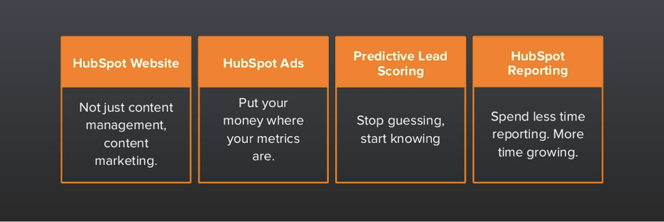
Perry took the opportunity to walk the audience through the CRM dashboard and how exactly it helps to monitor and manage customer relations through the various stages of the sales funnel.
The main takeaway is that with an integrated CRM portal, there’s no longer a need to export, import, and transport data between your different marketing and sales tools. The one-stop-shop approach makes things simple and convenient while removing many of the obstacles that would prevent users from properly processing and responding to all their data points.
As Perry neatly summarized the basic value offering of the integration, “we need to spend less time on reporting & more time on generating leads.”
Matthew Barby: Uncovering & Harnessing Trends in Content Performance
Matthew is the Global Head of Growth & SEO at Hubspot. So naturally, when he speaks people listen. You didn’t listen? You weren’t there? Lucky for you, I’m a great listener.
Marketers often get a bum rap for being full of hot air. As the critique goes, we’re little more than glorified showpeople; we look and sound nice but we speak in abstractions and lack for concrete and measurable actions capable of growing ROI.
We can rouse a boardroom to rapturously nod their heads in agreement with our platitudes, but after we step out the door and the dust settles, everyone’s left wondering what exactly we brought to the table.
It’s a common trope and to be perfectly honest, I think it rings true far too often. That said, what may lamentably be the case for many (perhaps even most) marketers, is made up for in spades by those who resist its classification. Such is the case with Matthew Barby.
In my time as a marketer, I’ve heard more than my fair share of bluster. So it comes as quite a testament when I say that Matthew’s presentation was not only bluster-free but chalked full of actionable, clear-headed advice.
Taking a lesson from Matthew, I’ll stop my rambling here and just get to what he said. In short, Matthew’s message was that a little bit of intelligent insight and augmentation can outdo a lot of work. How so?
Great Content Is Not Enough
Matt shared a very interesting piece of internal research out of HubSpot. Always looking to gain any and all insights into the connection between content and lead gen, HubSpot commissioned a review of their blogging activities.
They discovered that 46% of their monthly blog leads came from just 30 posts. That’s thirty, 3 – 0, out of over six thousand. Think about it this way – if HubSpot could tap into the same demand for the rest of our content as it does for its 30 best posts, they could increase their leads by a hundred times!
That fact stands to boldly demonstrate the fundamental content marketing truism that “just because you built it, doesn’t mean they’ll come.” Understand that basic point well. It lies at the core of all of Matthew’s recommendations.
Want Your Audience to Dig Your Content? Dig into Your Audience
What Matt took away from the HubSpot report was a keener appreciation of the fact that content is only valuable insofar as its perceived to be so among its audience. In other words, we write for our audience but we almost always fail to adequately consider and internalize what it is that our audience craves.
By and large, the quality of the content is not what separates those 30 pieces of content from their 6,000-some monthly counterparts; It’s the demand. If you could hone in on that demand and focus solely on serving it, your results will increase dramatically, holding all your other material and time inputs constant.
To better understand your customer personas, Matt suggests running surveys, focus groups, and embedding tracking pixels on your website to generate better visitor data.
He also recommends searching and participating in online forums such as Quora and Reddit as a way of gathering deeper insights into your market, their motivations, and pain points.
And perhaps most important of all, Matt reminds us of the most obvious and somehow neglected resource marketers have at their disposal: the sales team. These are the people who engage your customers most intimately post-conversion. They have a wealth of knowledge and it’d be a crime to not take advantage of it.
Contextualize Your Data to Build Actual Intelligence
Matthew proposes a unique method for processing your audience information. He suggests you group the interests and problems you’ve collected into broad topic groups, or as he calls them, clusters.
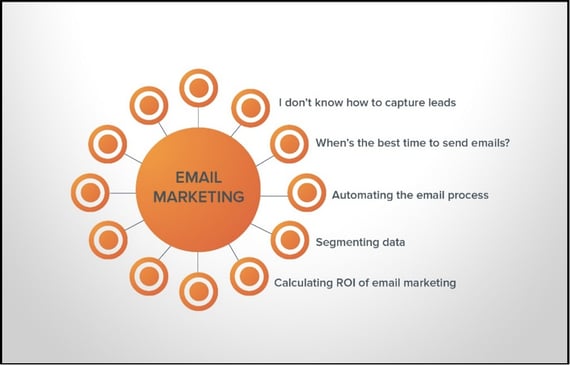
Once you’ve done that, you can perform keyword research around those clusters just as you would any other subject. (Remember to break down your keyword research into head and long-tail phrases.)

After you’ve done so, it’s important to go back and assign each keyword phrase to it’s most relevant cluster. If a new cluster emerges, that’s okay too. (Everything will need to check out through a verification process anyways.)
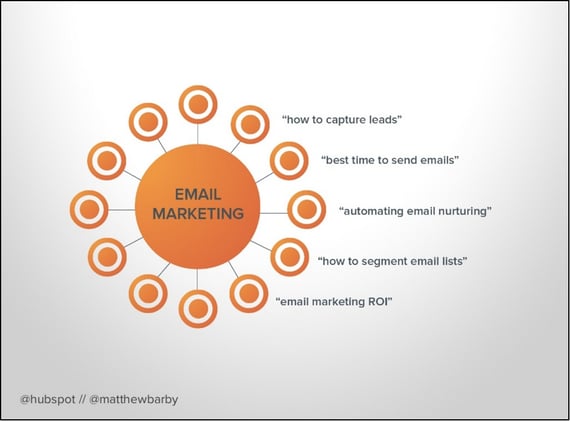
The next step is developing content ideas based on your keyword cluster map. At this stage, you’re essentially looking to engage and provide insights surrounding your keyword phrases in easy to digest and interesting ways.
Putting the Final Touches in Place
For each blog topic you come up with, you’re gonna want to validate it as being in line with your audiences wants and needs. To do that, refer to the same sources you relied on earlier in the process: focus groups, cookies, online forums, sales etcetera.
Finally, Matthew concludes his content process with one final tweak that quickly and easily boosts results. The more that your Call-to-Action matches your initial content offering the better.
Your blog is the corridor to your gated content and as such there should be continuity. You want to offer more premium though closely related content.
Once you see what’s working, you can redesign your CTAs to include the keywords that generated your traffic to begin with.
Carlos Abler: The Value of Centralizing Content Hubs
Carlos is the Content Marketing & Strategy Lead at 3M. Carlos’ presentation focused on meeting complex challenges in content marketing by harking back to simple truths.
Specifically, Carlos endeavored to explain how a unified enterprise content strategy can be designed to holistically align with customer needs across an organization as massive, diverse, and complicated as 3M.
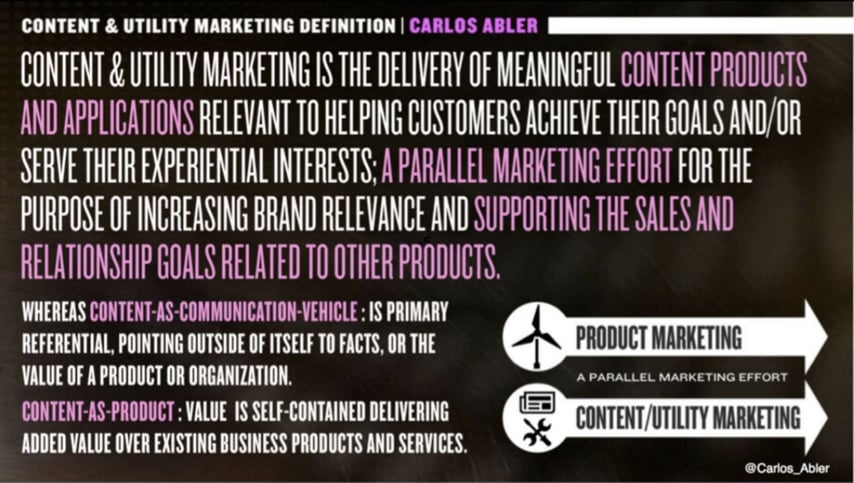
Carlos’ talk actually complemented Matthew’s quite nicely. They both pertained to building out a content strategy with forethought and organized purpose.
To me, that was the main takeaway from Carlos. The need to work with purpose. Every action must fit within your strategic scheme. To build a strategic scheme, you need to understand the basic concept behind content marketing.
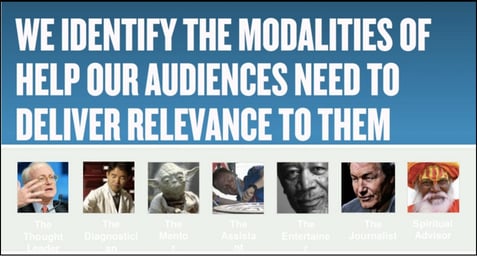
Content must represent meaningful value to customers, whether direct or referential, in accordance with their goals and interests. For cogency’s sake that value should also tie in to and encourage interest in your product/service offerings.
That’s the general idea, but how exactly is it pursued? For Carlos, order is key – and the best way to organize your efforts is by asking a series of questions to guide the process.
In answering these questions, you should be able to structure a content marketing process that integrates into your core marketing processes.
That’s important when you’re trying to holistically align content with customer needs across the organization.
Who Is Your Target Audience for the Content?
I should note that this is an interdisciplinary undertaking and to do it properly you’ll need to become a student of audience modalities, content culture frameworks, and process integration. Don’t let that scare you though, the process is rewarded and effective and you will come out the other end as more well-rounded marketer.
This is a complex process and, if lacking proper controls, can lead to an unwieldy mishmash of concepts, goals, and directives. To control the beast, Carlos takes an entirely top-down approach to prioritize, class, and sublimate each item within the organizational hierarchy.
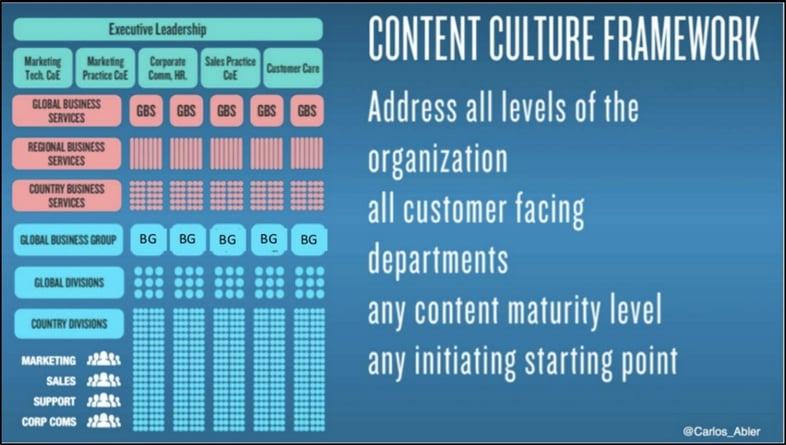
What Needs/Goals/Pain Points Will You address?
Once you’ve gained greater insight into your audience, you’ll be able to begin planning how to communicate value to them. First you need to determine what you’re communicating, then you’ll shift your focus to how.
The what is simple. Find the things that keep your prospects awake at night and employ any resources at your disposal to formulate an effective remedy to their frustrations.
Those formulae are the subjects for your content offering. The trick is "atomizing" those subjects for valuable and plentiful marketing content.
What Tactics Will You Use and How Will They Serve the Customer?
With your subjects in mind and at hand, put yourself into the mindset of your customers at the various stages of their journeys. Try to identify at least one engagement tactic per lifecycle stage.
Broadly speaking, engagement tactics include content curation, research pieces, reports, eBooks, audio and video materials, infographics, and emails.
Place your staged tactic ideas on a board and begin to physically map out the process. Similar to Matthew’s instruction, Carlos suggests that you’ll find it helpful to create interest clusters where you see themes emerging.
What Are the Calls to Action Tying Your Tactics Together?
Carlos stresses the creation of CTAs that link an engagement tactic in one stage to another in the next stage. Identify the status of your leads as they answer the Call-to-Action. If someone responds to a particular tactic, are they:
- A prospect?
- A lead?
- A sales qualified lead?
Take note of the point at which a sales qualified lead becomes disqualified, and should be pushed back to the nurturing process, or altogether removed from the funnel.
These lead-tracking activities will keep your program organized and your actions properly calibrated to best slide people through your funnel.
What Is the Business Goal You Wish to Advance with the Content?
Remember when we said that you need to work with purpose? Ultimately, all your marketing activities need to feed your business model. This step ensures that you’re securely tethered to bottom-line business sense.
Identify a quantifiable business goal e.g. “increase market-share of product X by 1% in 2016.” Assign a value to this business goal e.g. “1% = 1 million dollars.” Then place that goal on top of the Goal Pyramid.
Divide the value of the business goal by your average customer value. This will yield the number of customers needed to realize your business goal.
Then take the inverse of your conversion rate – the number of leads you need to produce a customer - and multiply it by the number of customers needed.
This will tell you:
- The number of leads you’ll need
- The maximum justifiable expenditure per customer
- The maximum justifiable expenditure per lead
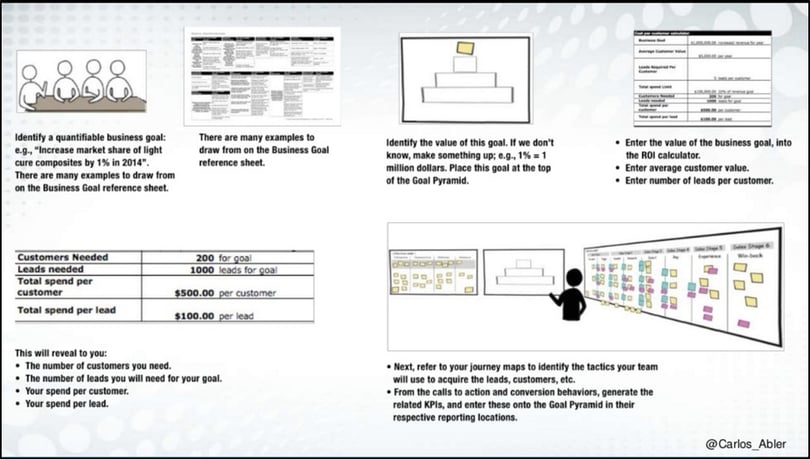
What Indicators Will You Use As A Measurement of Success?
Finally, refer to your journey map to identify the tactics you’ll use to acquire prospects, leads, and customers.
From the Calls-to-Action and conversion behaviors, determine the related KPIs and enter them into the Goal Pyramid in their respective reporting locations. Now you have everything in place for a unified enterprise content strategy. Go execute.
After having the privilege to hear such stellar industry experts speak, there’s little doubt that I'll be a better marketer in 2016 than I was in 2015. I’m equally confident that that’s true for most of the attendees of the recent HUG Israel meetup. If that doesn't constitute success by any measure, I'm not sure what would.
I’m already looking forward to the next meetup.

by The Penguin Team on December 15, 2015
As a leading B2B digital marketing agency, We help B2B Technology Companies, enterprise software, and hardware companies increase brand awareness, reach more qualified leads and close more customers. Penguin Strategies is a Diamond Partner of HubSpot.





